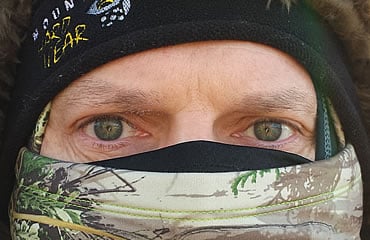A facemask can keep you in your stand, but don’t let it ruin your hunt.
Deer hunting the late seasons requires you to endure one difficult obstacle: Staying in your stand through cold temperatures. Even if your cold-weather vigils are shorter than your hunts from earlier in the season, it doesn’t take long for your nose and ears to get painfully chilled to the point you sometimes give up and go home.
We lose a high percentage of our body heat through our heads, and while virtually everyone wears a hat of some kind, fewer wear face coverings. Not only does a face covering (mask) help by eliminating direct contact between your skin and cold air, it also harnesses your breath and holds it in to retain warmth.
There are several drawbacks to wearing a facemask, however.
First, they can be uncomfortable. Many shift as you turn your head to scan for deer, causing poor fitting or blocked vision. Next, once you’ve worn a facemask for a few minutes, it’s likely you won’t be able to remain on stand without it. Don’t put one on unless you intend to wear it for the duration of your hunt. Finally, that same warm breath that is held close to your face by the mask also fogs up binoculars and scopes instantly. A fogged scope is a sure way to miss out on a chance at a giant buck.
The best way to avoid fogging while using a facemask is to remove it when you see deer. You don’t have to completely remove your facemask, but you must uncover your mouth and nose and allow your breath to be instantly cooled by outside temperatures.
When shopping for a mask, try to find one that has a wind-blocking membrane for the best ratio of warmth to weight. If you don’t find what you’re looking for in the hunting isle, check in the hiking/climbing gear.
We don’t recommend wearing a facemask that is all one piece from your head to your chin – the kind with two eyeholes. Masks that have a larger, single oval opening around the eyes are fine since the lower portion of the mask can be pulled down out of the way. Masks that cover only the lower half of your face are easy to pull down, too, but they provide less warmth in the head and ear areas.
Choice of style and weight of your facemask depend on temperatures, wind, and whether you’re hunting in an enclosed blind, an open stand or on the ground. It never hurts to take a few different options in case your first choice is either too light or too heavy for conditions.
Read Recent Tip of the Week:• January Scouting: This is a great time to get a better read on local deer behavior.




.png)